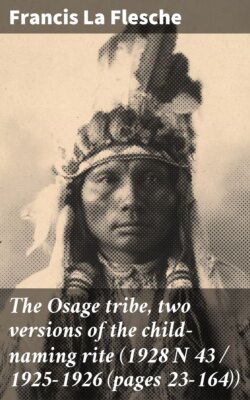Читать книгу The Osage tribe, two versions of the child-naming rite (1928 N 43 / 1925-1926 (pages 23-164)) - Francis la Flesche - Страница 24
На сайте Литреса книга снята с продажи.
4
Оглавление16. Toward what shall the little ones take their footsteps? they said to one another.
17. It is the Female Star (the moon) who sitteth in the heavens,
18. Toward which the little ones shall take their footsteps.
19. When the little ones take their footsteps toward the Female Star,
20. They shall always live to see old age, O, younger brothers, they said to one another.
The words of the processional song:
Into a star you have cast yourself,
Into my star you have cast yourself, etc.
are addressed to the child upon whom is to be conferred his personal, gentile name, and who is to be given his place in the Puma gens into which he was born. The star referred to in the song is the sun, the greatest life symbol of the Puma gens.
In the first section of the “Footstep Wi´-gi-e,” which the Xo´-ḳa recites as he makes his processional approach to the House of Mystery, the sun is referred to as the “Male Star.” The first line of the wi´-gi-e, “Toward what shall the little ones take their footsteps,” implies that much thought was given by the ancient Noⁿ´-hoⁿ-zhiⁿ-ga to the question as to the places where prayers for aid for the attainment of long life should be directed. The lines that follow imply that the Noⁿ´-hoⁿ-zhiⁿ-ga had finally arrived at the belief that if the “Little Ones” go with their prayers to the “Male Star,” the sun, they would find the way by which they could reach old age. The authors of these peculiar rites in speaking of long life did not only mean the attainment of old age by the child but they also meant the continuity of its life by procreation.
In the second section of the wi´-gi-e the moon is referred to as the “Female Star.” The same form that is used for the sun is also used for the moon. The pairing of these two great cosmic bodies in this wi´-gi-e suggests a procreative relationship between the two. The last two sections of the wi´-gi-e are repetitions of the first two. These repetitions are made in order to complete the mystic number four. The moon, referred to in the second section as the female star, is the life symbol of the Wa-ça´-be, or the Black Bear gens.
When the Xo´-ḳa have finished reciting the first section of the Footstep Wi´-gi-e, which speaks of the approach of the little ones to the sun, he and the Sho´-ḳa continue their march. Again they pause and the Xo´-ḳa recites the second section which tells of the approach of the little ones toward the moon seeking for long life. The fourth pause brings them to the door of the House of Mystery, which they enter, followed by the A´-ḳi-hoⁿ Xo´-ḳa and the Noⁿ´-hoⁿ-zhiⁿ-ga of the Puma gens who are to give their child a place in the visible universe. They take their place at the east end of the lodge where sit the father and mother with the child. The Noⁿ´-hoⁿ-zhiⁿ-ga who had been called to take part in the ceremony also enter and take their fixed places, those belonging to the Hoⁿ´-ga great division at the south side and those of the Ṭsi´-zhu great division at the north side of the lodge. (Fig. 1.)
